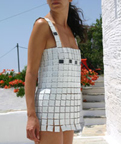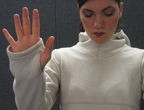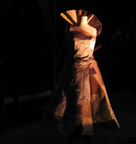July 26, 2006
Unravel: the SIGGRAPH2006 Fashion Show

Garments as Secondary Skins
Unravel: the SIGGRAPH2006 Fashion Show presents a runway show of innovative and experimental works in computational and conceptual couture, fashion with a social agenda, science-inspired form, and new technologies of material fabrication. Unravel brings together the work of designers and artists from the US, Canada, Europe, and Asia who are seeking to redefine the notion of ‘wearable.’
In the increasingly mobile nature of contemporary life, it has become important to contemplate how the devices we carry and the garments we wear converge into a ‘secondary skin’ which function as an extension of ourselves, in both ability and perception. By using fashion, a medium which has always been associated with self-expression and personal identity, these designers seek to demonstrate how the use (or misuse) of technology and its modes of production have the power to stimulate, delight, and inspire in ways as yet untapped in the fashion world.
Gone are the stereotypical bulky cyborg devices; what emerged are garments of beauty, subtlety and elegance in form. Some bring to light important social issues — redefining our notions of personal space, networked environments, and issues of privacy and protection. Others relish in pure delight, reminding us how technology also has the power to enhance our personal relationships and celebrate fantasy and play as part of the human condition.
A few projects:

Day For Night (Modular Extensible Reconfigurable) by Studio 5050 - Despina Papadopoulos & Jesse Lackey: Day-for-Night: a dress comprised of 436 white circuit boards that are linked together with metal rings. Each tile is addressable from a central control unit at the back of the dress. Solar cells are embedded on some of the tiles and charge the dress during the day. The dress is completely modular both in hardware, as new tile functionalities can be added and in terms of software. The control unit has an RF receiver module which can receive new programs from a programming USB board with an RF transmitter.
IPV – Clothing System by Adam Whiton (Industrial Designer and Artist) and Yolita Nugent (Apparel Designer): a wearable system designed to intervene in domestic violence situations.

The smart clothing utilizes pressure sensitive fabric to measure impacts to the wearer’s body. The physical abuse data is transmitted to a remote server where it can be archived or distributed to a trusted community or proper authorities. The wearer can chat with their IPV clothing via an artificial intelligence agent that offers them feedback and suggestions based on the received data. This project explores the wearable as a self reflective safe space to assist the abused wearer in reconnecting with social networks. [Also see the No-Contact Jacket]

Peau d’Âne by Valérie Lamontagne (Artist and Designer), Lynn Van Gastel (Fashion Design), and Patrice Coulombe (Technical Design): In the Charles Perrault fairy tale “Peau d’Âne” a young princess, whose stepfather’s riches are dependant on his gold excreting donkey, orders the impossible from her doting father in order to avoid having to marry him: three dresses made of immaterial materials: the sun, moon and sky. The aim of the project “Peau d’Âne” is to incarnate these “impossible” dresses in a material form. A weather antenna culls live weather data, which transforms the dresses, reflecting the changing barometric characteristics of sky, moon and sun in real-time. The “Sun” dress is based on changes in the sun. The dress will be constructed with a checkerboard of LEDs (light emitting diodes) set in motion based on UV, solar radiation and sun intensity readings.
Posted by jo at July 26, 2006 10:18 AM
